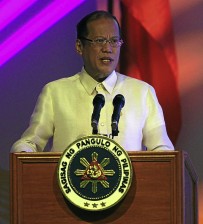
“During Ondoy, the government had difficulty helping our people. Don’t think we’re finding it easier now. But I think the people don’t feel as desperate now. As you said some of our countrymen can afford to wait for the rescue services to come back for them, as opposed to before when they were pleading for help. I think they’re confident that the rescue teams will come back for them,” Aquino told reporters after presiding over a disaster meeting in Camp Aguinaldo.
Aquino recalled that in the aftermath of Ondoy, when he was still a senator, it took 24 hours to reach a political ally who was isolated by the floods that inundated Metro Manila.
“We had some sense of helplessness then. I was in Mindanao at that time, and I didn’t know how to help our colleagues in our office. Now there are many people who get to send text and tell where they are, and I believe that’s being acted upon immediately,” he said.
Aquino, however, said it was up to the people to judge if there was a difference between the way his administration handled the situation Tuesday and the Arroyo administration’s performance during the Ondoy disaster.
When Ondoy (international name: Ketsana) dumped heavy rains on the morning of Sept. 26, 2009, a wide swath of Metro Manila was submerged in floodwaters within hours.
Directives
As hours of heavy rain Tuesday inundated parts of the capital, central and southern Luzon, and floodwaters continued to rise, Aquino convened the National Disaster Risk Reduction and Management Council to assess the damage and draw up emergency measures.
Aquino issued the following directives:
— For the Air Force to inventory their assets for deployment to flooded areas to complement rescue boats, and for the Metropolitan Manila Development Authority to ensure that there was no duplication of the effort.
— For the Department of Social Welfare and Development to check the distribution of relief supplies.
— For the Department of Trade and Industry to check hoarding.
— For the Philippine National Police to activate its radio communication in case the operations of mobile service providers bog down.
— For the Department of Science and Technology to continue issuing updates on the rain and floods.
— For the deployment of rubber boats for search-and-rescue operations and provisions for displaced families in evacuation centers.
“I think everybody is supposed to do something on what they are supposed to do and improve what they’re supposed to do,” he said.
With the water in
Now that the water in Laguna de Bay has risen to 13.30 meters above sea level, the floods in several towns around it, particularly in Laguna, Quezon and Rizal provinces, could last for two months, said Public Works Secretary Rogelio Singson.
“What needs to be done in terms of intervention is to reduce the volume of water from Marikina and adjoining mountains around Laguna Lake,” Singson said.
Health Secretary Enrique Ona expressed concerns over the possible rise of cases of water-borne diseases, and diarrheal diseases, and raised the need of hospitals for potable water supply. Public works officials said they could supply potable water to hospitals.
Aquino said the P6-billion calamity fund was still intact to address the emergency.
Aquino’s appeal
The President appealed to Filipinos for “a little cooperation” in the government’s rescue and evacuation efforts.
“There are some who don’t want to leave their rooftops, and the rescue services have to turn back because they refuse to be rescued,” he said.
Aquino said he understood those who did not wish to part with their possessions.
“But our lives are more important. The rescuers are even put at risk because they need to keep going back to the areas (to look for others who are trapped),” he said.
Aquino noted previous reports of people who did not take seriously the weather bureau’s red warning signal indicating torrential rainfall.
“There was one who went swimming and drowned. There was someone who had a heart attack while having alcoholic drinks. Another one tried to cross a raging river,” he said.—With a report from DJ Yap